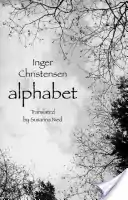Alphabet (poetry collection)
Alphabet is one of the most well-known poems[1] of Inger Christensen,[2] who was broadly considered to be Denmark's most prominent poet.[3] The poem was originally published in 1981 in Danish as alfabet. An English language translation by Susanna Nied won the American-Scandinavian PEN Translation Prize in 1982.[4]
 | |
| Author | Inger Christensen |
|---|---|
| Original title | Alfabet |
| Translator | Susanna Nied |
| Country | Denmark |
| Language | Danish |
| Publisher | Lyrikbogklubben Borgen, Gyldendal, New Directions |
Publication date | 1981 |
Published in English | 2001 |
| Pages | 77 |
| ISBN | 081121477X |
Structure
Alphabet is a systematic poem, in which each of the fourteen sections[3] of the poem is tied to a letter of the alphabet and the number of lines found in each section is dictated by the Fibonacci sequence.[5] (The first section, "A", has one line. The last section, "N", has 610.)
Themes
Alphabet deals with themes of nuclear war and ecological devastation.[5][6]
As the poem progresses and each section lengthens, an increasing number of elements related to destruction, death, and ecological devastation are introduced.[6] The sections progress through the alphabet, finishing on the letter "N", for nuclear destruction, suggesting a premature end to the enumeration of splendours.[7] The use of the Fibonacci sequence, Christensen later realised, was particularly appropriate for a plea that life can continue. "I found out after I had written alphabet that many plants follow these numbers. For example, sunflowers are ordered with the Fibonacci sequence - it's the way the seeds are placed."[8]
Reception
The book was reviewed in Publishers Weekly in 2001: "As used here with controlled repetitions, the [Fibonacci] sequence gives the whole an almost medieval sense of restriction[.] Abstracted cold war fears and post-'70s ecological concern and alienation give way to litanies of real world outrages ... which culminate in a post-nuclear holocaust nightmare, with birds and children somehow having survived in caves. The scenario may seem dated, but the threats remain very real, and Christensen's poetic appeal for sanity and humanity remains an abstracted call to action."[9]
See also
References
- Williamson, Marcus (2 February 2009). "Inger Christensen". The Independent. Archived from the original on 11 April 2013. Retrieved 13 February 2013.
- "LCCN Permalink: Alphabet". Library of Congress. Retrieved 13 February 2013.
- Fox, Margalit (12 January 2009). "Inger Christensen, Scandinavian Poet, Is Dead at 73". New York Times. Archived from the original on December 9, 2013. Retrieved 13 February 2013.
- Cushing, Iris. "Susanna Nied on Translating alphabet by Inger Christensen (Part One)". Circumference Magazine. Retrieved 13 February 2013.
- Whitener, Brian (22 September 2001). "Alphabet. (Brief Reviews)". Chicago Review. Archived from the original on 10 June 2014. Retrieved 13 February 2013.
- Commire, Anne; Klezmer, Deborah, eds. (1999). Women in world history a biographical encyclopedia. Waterford, Conn.: Yorkin Publications. ISBN 978-1-4144-1267-2. Archived from the original on 2014-06-10.
- "What We're Reading: Inger Christensen's Alphabet". The Cincinnati Review. 2017-12-20. Retrieved 2021-09-20.
- "I did not sit down and say 'now I will write a catastrophic poem'". The Irish Times. Retrieved 2021-09-20.
- Staff writer (2001-05-14). "Fiction Review: Alphabet by Inger Christensen". Publishers Weekly. Retrieved 2012-02-13.